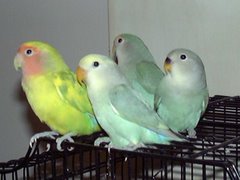How to Stop Lovebird Biting?
Babies and beaks
Like any other species the love birds baby too will explore with its beak. The beaks of the baby love bird will be very sensitive. Hence one should never play with it any time. The flicking or pulling the beak will be highly dangerous and hence discouraged in total. The baby love birds may use the beak for grip purpose. You should never mistake this as bite. The beak for the love bird is almost like the hand for them. The love bird’s babies who are on the formula feed should not be permitted to explore their beak. Once the birds are weaned and are socializing, the bird is permitted to explore the beak.
Nibbling juvenile
The love birds start using their beak for nibbling before biting. If you find the love birds biting the finger all of a sudden without any provocation, then you should enquire the owner about the birds. They will invariably tell you that their birds has been nibbling their finger for long time.
Hence, if you are first time love bird owner, then please be informed that the nibbling activity should be discouraged from the beginning. The birds should be admonished as NO BITING firmly and the birds should be getting rid of the shoulder or ear where she is sitting at the time of biting. Few birds will not obey and correct their behaviour immediately. One should not get tired and should continue the practice till the birds start behaving well.
Distraction method
Distracting the bird is the best method to stop nibbling. Unscented Kleenex or untanned leather will be enough to distract the love birds from biting the finger. At times the love birds may be wary of the thing that you offer to them. One need to play with the item as if it is the toy and the love bird that is watching this will attempt to bite it and will soon forget biting your finger by shear distraction.
Holding the beak
If the love bird is not stopping the habit of biting even after your best efforts, one can think of holding the beak method. As per this method the love bird beak should be held between the thumb and finger gently and NO BITING should be shouted. Make sure the beak is not damaged in the process.
Time out
Some birds may not change the biting habit that easily. For such birds time out cage method will be of immense help. Time out cage is a small cage which is used commonly to teach a lesson. If the love bird is biting you in spite of the reminders, then take the love bird out and give him no bite command. Let the birds be kept in time out cage for few minutes let us say five minutes. This time out cage will have only a cup of water and no toys in it. When the love bird is in the time out cage, then there should not be any talking, scolding or discussion with the bird.










 Free Ads For Bloggers
Free Ads For Bloggers

